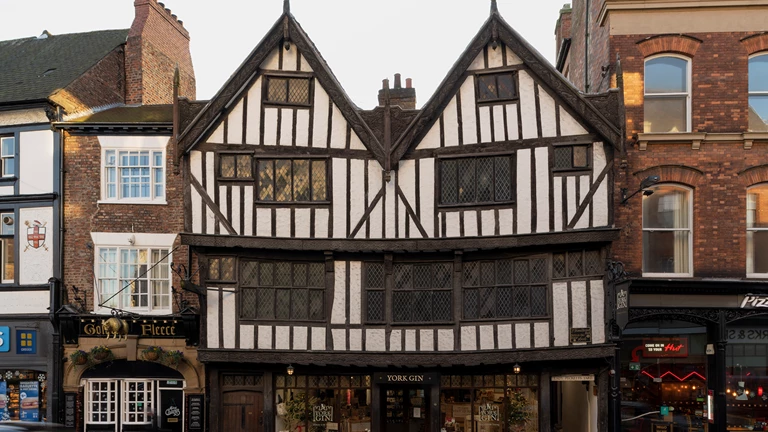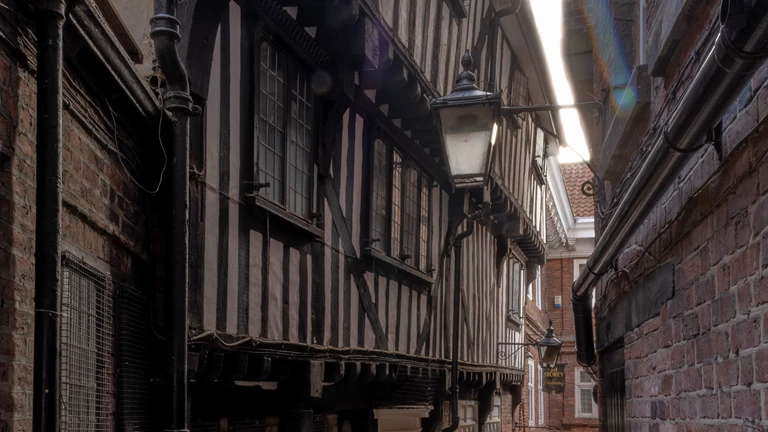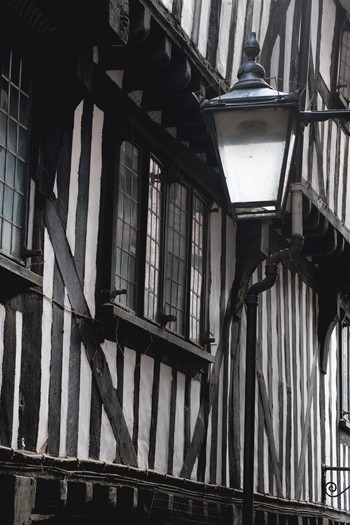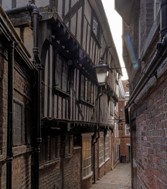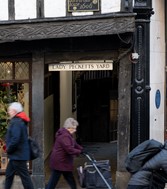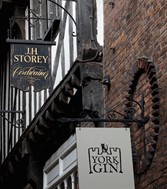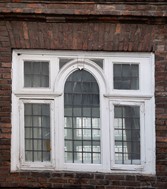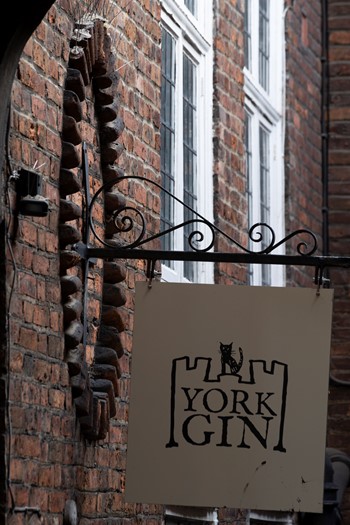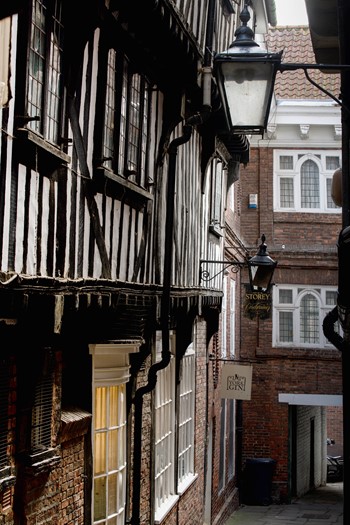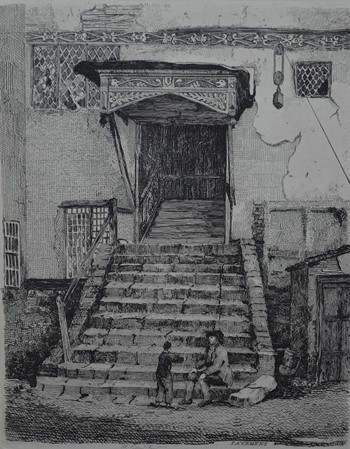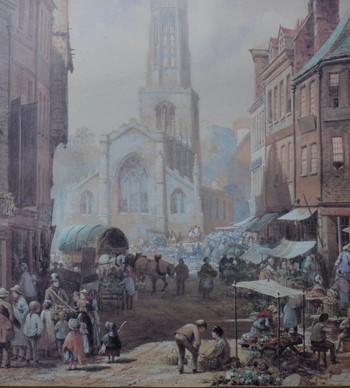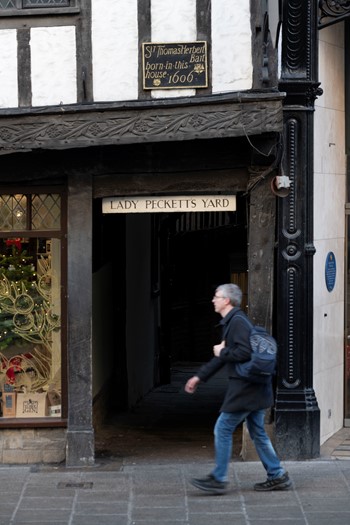Herbert House and Lady Peckett's Yard
One of York’s most fascinating and elaborate, surviving Tudor buildings
The attractive black and white timber-framed, Herbert House stands on an ancient York thoroughfare known as Pavement. Looking up from the street you can see intricately carved bargeboards, which hide the roof’s timber ends and facias carved with intricate grape, flower and ribbon patterns, or strap work, all a foretaste of the building’s famous inhabitants and fascinating history.
For many years, Pavement was home to many of York’s wealthiest merchants and Herbert House, home to four Lord Mayors from 1573 to 1702, was the most significant of them all. To the right of the building you’ll discover a snicket, or passageway, called Lady Peckett’s Yard. Named after Alice, wife to Lord Mayor John Peckett in 1702, the snicket itself was created earlier and originally provided a direct route between Pavement and Merchant Adventurers’ Hall.
Herbert House
Built in around 1545, the house is named after the Herbert family, a wealth dynasty of merchants and Lord Mayors. In 1557 Christopher Herbert, a member of the Company of Merchant Adventurers, bought the house from the Company for around £54. Lord Mayor of York in 1573, he remodelled the interior to allow for both residential and commercial activity. By 1590 his son was in possession, also serving as Lord Mayor in 1604.
The most famous ‘Herbert’ was the traveller, historian and courtier, Sir Thomas Herbert. Thomas was born in Herbert House in 1606 and, as a young man, joined a mission to the Shah of Persia in 1626, famously writing about his travels and the exotic bird life he encountered. Appointed as a Gentleman of the Bedchamber to King Charles I, Thomas helped entertain the King on his visit to York in 1633. An important figure in the English Civil War (1642 – 1651) Thomas was initially a Parliamentary negotiator before becoming a Royalist sympathiser, keeping company with the King on his walk to the executioner’s block in January 1649.
Welcoming the King
Sold by the Herberts in around 1620 to John Jacques, it was Jacques who added the current elaborate frontage and his son, Roger, a Lord Mayor like his father, entertained King Charles on his second visit to York in 1638. The house is also where Roger and the Recorder of York, Thomas Widdrington, were knighted.
Styled as two open shops throughout the 18th century, later occupants included cutlers, glove and surgical instrument makers. In 1826 the whole property was sold to J H Wilson & Co Linen Drapers and in 1862 it was bought by York’s well-known quaker philanthropists and chocolate manufacturers the Rowntree family, who carried out major renovation works and ran their confectionery business from there until 1925.
The next owners, the Farmers Union Pension Fund, undertook restoration work under the guidance of the antiquarian architect Francis Yorke. Much of the interior has been altered over time but some original features survive. Facing out to the street, the large first-floor chamber has a fine 17th century oak panelled overmantel; restored and enhanced in the 1920s. Some of the ceiling beams would have been covered in decorative plasterwork, but these are now laid bare.
By the 1940s it was Curry’s Radio and Cycles shop and in 1946 it was bought by Ings Property Co, which would later become York Conservation Trust, to help ensure this important building’s place in the commercial life of the city. For many years home to Clarks Shoes, many York residents still remember bringing their children to buy their shoes here and, more recently, from Jones the Bootmakers. The upper floors were let to the relationship counselling service Relate.
Today, Herbert House is home to York Gin.
York Conservation Trust is currently undertaking a series of surveys for a full scheme of refurbishment to be undertaken over the next few years.
Discover more about Herbert House
12 Pavement
York
YO19UP
Operated by York Gin
Tel: 01904 848900
Email: orders@yorkgin.com
Herbert House Historic England Grade l listed building
Lady Peckett's Yard
To the right of Herbert House you’ll find Lady Peckett’s Yard, which is, in fact, not a yard at all but a narrow alley for foot traffic. From historical documents we know that there was a small courtyard set in the middle section of Herbert House, together with a large 17th century stairway giving access to the rear of the building. The passage and yard were remodelled around 1638 and, at some stage, the courtyard was enclosed, the stairway removed, and small workshops created for artisans, including cordwainers and joiners.
The passageway also provided direct access to the Merchant Adventurers, the guildhall of York’s highly influential civic and mercantile organisation throughout the post medieval period. John Peckett, Lord Mayor in 1702, lived with his wife Alice at number 11.
Architectural puzzle
Walking down Lady Peckett’s Yard you’ll find plenty of interesting architectural features. Near to the bottom of the passageway, on the left the building, you’ll find a façade of brick with a bold brick stringer course at second floor level. Above this is a heavy over-scale timber cornice supported by large, highly decorative Palladian style brackets. These oversized features are puzzling, but perhaps there’s a clue to their origin in the work of the renowned York Architect John Etty.
Etty had used around 60 remarkably similar carved brackets for Sir John Goodricke’s imposing French-style country house at Ribston Hall, near Wetherby. Were these prototypes or spares, bought from Etty’s workshop on North Street by an upwardly mobile John Peckett to add consequence to his home?
Discover more about Lady Peckett's Yard
12 Pavement
York
YO19UP
Lady Peckett's Yard Historic England Grade ll* listing building
Pavement
Herbert House and Lady Peckett’s Yard are found facing Pavement, for hundreds of years one of York’s important civic and public spaces.
A well-established thoroughfare well before the Norman conquest in 1066, Pavement sits between the two parish churches of St Crux and All Saints Pavement. It was the location of one of York’s two major markets (the other being at Sampson Square) and in 1572 the Earl of Northumberland was beheaded here at the behest of Elizabeth I.
With its direct route, via Lady Peckett’s Yard, to the influential civic and mercantile Company of Merchant Adventurers’ guildhall, Pavement is at the conjunction of two important early medieval streets. To the left is All Saints Church and Coppergate, leading to King’s Staith dock on the river Ouse. To the right, Ousegate, and a direct route to York’s only bridge over the Ouse at the time. Pavement was also one of the main ‘stations’, or performance areas, for York’s renowned medieval Mystery Plays.
Given the amount of activity taking place in Pavement, it is difficult for us to comprehend what it must have been like in the late 17th century. You would have witnessed the noise and smell of the drovers and their livestock, including cattle, sheep, goats and poultry, being herded up Walmgate and Fossgate to be sold to the butchers with shops on the Shambles. The sellers of herbs and colourful spices, together with baskets and sacks of fruit and vegetables. All the traders calling out to advertise their wares and attract customers.
A fine, large market cross, designed by the amateur architect Thomas Mann in 1672 that once stood in the lea of All Saints Church, was also a regular meeting place for landowners’ agents recruiting day labourers for planting or bringing in the harvest.
There can be no doubt that the constant bustle, noise and smell must have been overwhelming, as hundreds of people converged on Pavement every day to buy and sell animals and goods, find work and ply their trade.
Why are Herbert House and Lady Peckett's Yard Significant?
This site represents a large and important assemblage of late medieval and post medieval buildings, incorporating two mid 16th-century and one early 17th-century timber-framed merchant houses. These are connected by stair tower additions, one dating from 1648 and the other from the late 17th century. At the rear is the partial remains of a Victorian house. The site runs along Lady Peckett’s Yard, which once connected the Pavement markets to the Merchant Adventurers’ Hall, home to the mercantile guild founded in 1396.
The oldest surviving building on Pavement, Herbert House was long associated with the cloth and linen trade, contributing to our understanding of York’s post medieval status, mercantile and civic culture. The appearance of the buildings today is the result of a major restoration in 1925 by Arts & Crafts architect, F W Yorke. This work potentially makes it one of the earliest examples of domestic timber frame restoration in York and an important moment in the 20th century preservation and conservation of the city.

